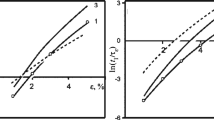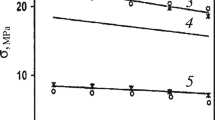The method of mathematical modeling of viscoelastic properties of textile materials having a complex macrostructure is used for sewing threads and for variously twisted polyester yarn constituting them. The efficiency of the methods of determination of physicomechanical properties and of prediction of deformation processes relating to these materials is checked. The qualitative dependence of the effect of twist of threads and yarn on their physicomechanical properties and on the relaxation time spectrum is determined. The effect of twist on the elastic components of deformation and specific mechanical work of deformation is studied.
Similar content being viewed by others
Explore related subjects
Discover the latest articles, news and stories from top researchers in related subjects.Avoid common mistakes on your manuscript.
A large variety of textile materials with diverse structures are used in textile and light industry productions. These materials may be divided tentatively into two groups, viz., materials having a simple macrostructure, i.e., various types of polymer threads, and composite materials with a more complex macrostructure consisting of a combination of simple materials, such as fabric, tape, yarn, tow, etc.
At present, the first group of materials, for which all kinds of mathematical models that satisfactorily describe their physicomechanical properties are constructed, is studied most comprehensively. Here, it is important to set off the model that is based on normal distribution of relaxing particles in terms of proper relaxation and delay times [1].
Despite the much larger variety of materials belonging to the second group, their physicomechanical properties have not been studied adequately. The reason for this lies in the fact that the mathematical models describing the physicomechanical properties of the materials of the first group fail to work here, i.e., it is essential to construct a model that takes account of the fact that relaxation times have a more complex spectrum than normal distribution [2].
The integral function and density of the desired distribution must resemble normal in form on the one hand and have significant distinctions, including broadened spectrum and delayed convergence to asymptotic values, on the other.
This type of distribution is observed among elementary functions, for example, distribution in accordance with the arctangent law. Affiliation of its integral function and density to the class of elementary functions and densities greatly simplifies integrodifferential transformations. Other similar distributions belong either to the class of special functions or are integral, which considerably complicates the mathematical model [3].
Threads used in clothing and knitwear productions must have adequate strength on the one hand and prescribed physicomechanical properties on the other at the point of impact of nondestructive mechanical stress and load that affect the mechanical properties of the end products during their use.
Getting breaking characteristics is the simplest task, for which it suffices to use conventional methods of construction of tensile-test diagrams. While determining other physicomechanical properties however, for example, mean statistical relaxation and creep times, based on which the modern methods of prediction of deformation processes are developed, the investigators face certain difficulties. These difficulties are bound primarily with the complexity of the macrostructure of the studied object, owing to which many methods conventionally applicable for synthetic monofilaments either cease to work or give a large error [4].
Textile objects having complex macrostructures are characterized by broader relaxation and creep spectra, due to which the mathematical model of physicomechanical properties ought to be constructed using relaxation and creep functions that take account of this characteristic. One of such functions is normalized arctangent of logarithm of reduced time (NAL), a useful feature of which, in comparison with other normalized functions, is its affiliation to elementary functions, which greatly simplifies integrodifferential transformations [5]:
where t is the time, t1 is the base time, and 1/bp is the structural parameter.
The goal of this investigation was to check the efficiency of the methods of determination of the physicomechanical properties and the methods of prediction of viscoelastic processes of textile materials with a complex macrostructure.
Determined also is the effect of twist of threads on their physicomechanical properties. Reinforced polyester sewing threads of several types (Petronit threads) manufactured by OAO NII Nitok (Scientific Research Institute of Petronit Fibers PJSC), out of which two types of polyester threads (PET-1 and PET-2), which differ most in linear density and twist degree (T) (Table 1), were chosen as the samples.
The chosen sewing threads have a complex structure, i.e., they are produced by twisting into a reinforced two-ply yarn (Table 1).
The yarn, in turn, consists of a core, which is a complex polyester thread that occupies 70-80 % of the yarn volume, and a braid of loosely twisted tape.
The diagrams of extension (ε) until breakup of both types of sewing threads (Fig. 1) and yarn (Fig. 2) were obtained on an Instron-1122 tensile tester.
The samples were extended at a sample base of 200 mm at the rate of 100 mm/sec, which corresponds to the rate of change of deformation \( \dot{\upvarepsilon} \) = 0.0083/sec.
For determining the main physicomechanical properties of sewing threads and yarns, a mathematical model suitable for determination of deformation characteristics of complex textile objects, such as yarn, fabric, textile tapes [6], etc., was used:
where t is the time, 1/bpε is the parameter of the relaxation process intensity, 1/bpσ is the parameter of the creep process intensity, τε is the relaxation time, τσ is the delay time, Eεt = σ/ε is the modulus of relaxation, E0 is the modulus of elasticity, E∞ is the modulus of viscoelasticity, Dσt = ε/σ is the compliance, D0 is the initial compliance, D∞ is the ultimate equilibrium compliance, ε is the deformation, and σ is the stress.
The “families” of relaxation (Fig. 3) and creep (Fig. 4) curves for the PET-2 type of sewing thread and similar “families” of curves for PET-1 and for yarn of both types obtained experimentally on a stress relaxometer were processed by a quick method using mathematical models (2) and (3). As a result, the main physicomechnical properties of these materials were obtained (Table 2, Figs. 5-8) [7].
Comparing the values of the obtained physicomechanical characteristics of the sewing threads and yarns (Table 2, Figs. 5-8) we find that the modulus of elasticity and the relaxation process intensity parameter decrease with increase of the degree of twist of both sewing threads and yarns.
The mean statistical relaxation times (Figs. 5 and 6) and the structural coefficient of relaxation bpε, which characterizes the width of the relaxation spectrum, increase simultaneously with increase of twist degree [8].
Note that, in all four types, the referred coefficient lies within 27 < bpε < 35, which, in comparison with synthetic threads, for which this parameter generally lies within 2 < bpε < 20, indicates widening of the relaxation spectrum.
The spectra of the noted width (27 < bpε < 35) are described well by the mathematical model constructed using the NAL function of reduced time (because of its relatively slow convergence to the asymptotic values) just as similar spectra of textile materials with a complex structure. Thus, it may be concluded that relaxation time spectrum widens with increase of twist degree.
Let us check the influence of twist on elastic components of deformation and specific mechanical work of deformation.
It is known that the process of thread deformation at the set rate \( \dot{\upvarepsilon} \) as the initial stage of the tensile-test diagram is analytically described by the phenomenological integral equation of the nonlinear hereditary type
As in a general case where \( \dot{\upvarepsilon} \) ≠ const, the elastic component of deformation can be determined by the equation
or by mathematical prediction using equation (4)
For a given point of the tensile-test diagram with the coordinates εt and σt the specific mechanical work (per unit volume) is calculated by the equation
or by the equation
The potential (elastic) component of the specific mechanical work \( {a}_{t0}=0.5{E}_0^{-1}{\upsigma}_t^2 \) and the dissipating part of the specific mechanical work att = at − at0 also are determined by any of the referred two equations.
Calculation of the specific mechanical work at0, the dissipation component att, and elastic component of deformation ε0 for both types of sewing threads (PET-1 and PET-2) and yarn (PEY-1 and PEY-2), taking account of NAL function, is given in Table 3.
As evident from Table 3, the elastic components of deformation and specific mechanical work increase with increase of twist of sewing thread and yarn of both types. This implies that the material with a greater degree of twist is more elastic, i.e., it recovers its original state better after deformation, which is expressed favorably in the performance qualities of the end sewing or knitting products [10].
On the other hand, decrease of the proportion of the component att in the mechanical work with increase of twist indicates decrease of the role of the viscoelastic factor.
References
A. G. Makarov, G. Y. Slutsker, et al., Phys. Solid State, 58. No. 4, 840-846 (2016). https://doi.org/10.1134/S1063783416040132
A. G. Makarov, G. Y. Slutsker, and N. V. Drobotun, Techn. Phys., 60, No. 2, 240-245 (2015). https://doi.org/10.1134/S1063784215020152
P. P. Rymkevich, A. A. Romanova, et al., J. Macromol. Sci., Part B: Physics, 52, No. 12, 1829-1847 (2013). https://doi.org/10.1080/00222348.2013.808906
A. M. Stalevich, Mech. Solids, 43, No. 6, 892-901 (2008).
V. V. Golovina, G. Y. Slutsker, et al., Polymer Sci. Series B, 49, No. 5-6, 143-147 (2007).
V. A. Berestnev, L. A. Flekser, and L. M. Lukyanova, Macrostructure of Fibers and Filaments and Their Breaking Characteristics [in Russian], Leg. i Pishch. Prom., Moscow (2006), p. 248.
A. M. Stalevich and O. N. Stolyarov, Fizikokhim. Polimerov: Svoistva i Primenenie., No. 11, 157-160 (2005).
A. M. Stalevich and B. M. Ginzburg, Techn. Phys., 49, No. 11, 1452-1456 (2004).
G. M. Bertenev, Strength and Mechanism of Polymer Degradation [in Russian], Khimiya, Moscow (2001), p. 280.
D. Bland, The Theory of Linear Viscoelasticity [Russian translation, Mir, Moscow (1965), p. 199].
The work was financed within the ambit of accomplishment of the state assignment of the Ministry of Science and Higher Education of the Russian Federation, Project No. FESZ-2020-0005.
Author information
Authors and Affiliations
Corresponding author
Additional information
Translated from Khimicheskie Volokna, No. 4, pp. 3-7, July-August 2021
Rights and permissions
About this article
Cite this article
Buryak, E.A., Klimova, N.S., Pereborova, N.V. et al. Mathematical Modeling of Viscoelastic Properties of Reinforced Polyester Sewing Threads. Fibre Chem 53, 223–228 (2021). https://doi.org/10.1007/s10692-022-10273-x
Published:
Issue Date:
DOI: https://doi.org/10.1007/s10692-022-10273-x












